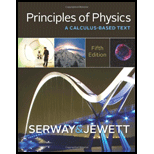
Concept explainers
(a)
The maximum linear speed of the heart wall.
(a)
Answer to Problem 40P
The maximum linear speed of the heart wall is
Explanation of Solution
Write the expression for the maximum speed.
Here,
Write the expression for the angular velocity.
Here,
Conclusion:
Substitute
Substitute
Therefore, the maximum linear speed of the heart wall is
(b)
The maximum change in frequency between the sound that arrives at the wall of the baby’s heart and the sound emitted by the source.
(b)
Answer to Problem 40P
The maximum change in frequency between the sound that arrives at the wall of the baby’s heart and the sound emitted by the source is
Explanation of Solution
The frequency of the wave when the heart approaches the source at maximum velocity is given by,
Here,
The maximum change in frequency is,
Use equation (III) in (IV),
Conclusion:
Substitute
Therefore, The maximum change in frequency between the sound that arrives at the wall of the baby’s heart and the sound emitted by the source is
(c)
The maximum change in frequency between the reflected sound received by the detector and that emitted by the source.
(c)
Answer to Problem 40P
The maximum change in frequency between the reflected sound received by the detector and that emitted by the source is
Explanation of Solution
The frequency of the wave when the heart approaches the source at maximum velocity is,
Use equation (VI) for the change in frequency when the heart wall is a moving source.
Here,
Use equation (III) in equation (VII),
Solve equation (VIII) for
Conclusion:
The velocity of the source and the observer in expression (IX) refers to the movement of the heart wall, and the velocity of the sound wave is much greater than those velocities,
Substitute
Therefore, the maximum change in frequency between the reflected sound received by the detector and that emitted by the source is
Want to see more full solutions like this?
Chapter 13 Solutions
Bundle: Principles of Physics: A Calculus-Based Text, 5th + WebAssign Printed Access Card for Serway/Jewett's Principles of Physics: A Calculus-Based Text, 5th Edition, Multi-Term
- As in Figure P18.16, a simple harmonic oscillator is attached to a rope of linear mass density 5.4 102 kg/m, creating a standing transverse wave. There is a 3.6-kg block hanging from the other end of the rope over a pulley. The oscillator has an angular frequency of 43.2 rad/s and an amplitude of 24.6 cm. a. What is the distance between adjacent nodes? b. If the angular frequency of the oscillator doubles, what happens to the distance between adjacent nodes? c. If the mass of the block is doubled instead, what happens to the distance between adjacent nodes? d. If the amplitude of the oscillator is doubled, what happens to the distance between adjacent nodes? FIGURE P18.16arrow_forwardThe bulk modulus of water is 2.2 109 Pa (Table 15.2). The density of water is 103 kg/m3 (Table 15.1). Find the speed of sound in water and compare your answer with the value given in Table 17.1.arrow_forwardA string with a mass m = 8.00 g and a length L = 5.00 m has one end attached to a wall; the other end is draped over a small, fixed pulley a distance d = 4.00 m from the wall and attached to a hanging object with a mass M = 4.00 kg as in Figure P14.21. If the horizontal part of the string is plucked, what is the fundamental frequency of its vibration? Figure P14.21arrow_forward
- The overall length of a piccolo is 32.0 cm. The resonating air column is open at both ends. (a) Find the frequency of the lowest note a piccolo can sound. (b) Opening holes in the side of a piccolo effectively shortens the length of the resonant column. Assume the highest note a piccolo can sound is 4 000 Hz. Find the distance between adjacent anti-nodes for this mode of vibration.arrow_forwardBy what factor would you have to multiply the tension in a stretched string so as to double the wave speed? Assume the string does not stretch. (a) a factor of 8 (b) a factor of 4 (c) a factor of 2 (d) a factor of 0.5 (e) You could not change the speed by a predictable factor by changing the tension.arrow_forwardThe wave is a particular type of pulse that can propagate through a large crowd gathered at a sports arena (Fig. P13.54). The elements of the medium are the spectators, with zero position corresponding to their being seated and maximum position corresponding to their standing and raising their arms. When a large fraction of the spectators participates in the wave motion, a somewhat stable pulse shape can develop. The wave speed depends on peoples reaction time, which is typically on the order of 0.1 s. Estimate the order of magnitude, in minutes, of the time interval required for such a pulse to make one circuit around a large sports stadium. State the quantities you measure or estimate and their values.arrow_forward
 Principles of Physics: A Calculus-Based TextPhysicsISBN:9781133104261Author:Raymond A. Serway, John W. JewettPublisher:Cengage Learning
Principles of Physics: A Calculus-Based TextPhysicsISBN:9781133104261Author:Raymond A. Serway, John W. JewettPublisher:Cengage Learning Physics for Scientists and Engineers: Foundations...PhysicsISBN:9781133939146Author:Katz, Debora M.Publisher:Cengage Learning
Physics for Scientists and Engineers: Foundations...PhysicsISBN:9781133939146Author:Katz, Debora M.Publisher:Cengage Learning Physics for Scientists and Engineers, Technology ...PhysicsISBN:9781305116399Author:Raymond A. Serway, John W. JewettPublisher:Cengage Learning
Physics for Scientists and Engineers, Technology ...PhysicsISBN:9781305116399Author:Raymond A. Serway, John W. JewettPublisher:Cengage Learning Physics for Scientists and Engineers with Modern ...PhysicsISBN:9781337553292Author:Raymond A. Serway, John W. JewettPublisher:Cengage Learning
Physics for Scientists and Engineers with Modern ...PhysicsISBN:9781337553292Author:Raymond A. Serway, John W. JewettPublisher:Cengage Learning Physics for Scientists and EngineersPhysicsISBN:9781337553278Author:Raymond A. Serway, John W. JewettPublisher:Cengage Learning
Physics for Scientists and EngineersPhysicsISBN:9781337553278Author:Raymond A. Serway, John W. JewettPublisher:Cengage Learning Glencoe Physics: Principles and Problems, Student...PhysicsISBN:9780078807213Author:Paul W. ZitzewitzPublisher:Glencoe/McGraw-Hill
Glencoe Physics: Principles and Problems, Student...PhysicsISBN:9780078807213Author:Paul W. ZitzewitzPublisher:Glencoe/McGraw-Hill





